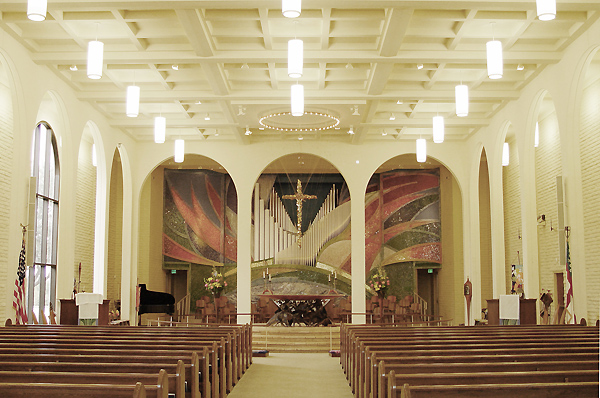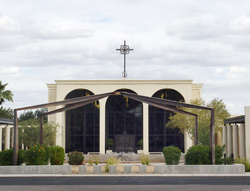Church sanctuaries are often aesthetically beautiful spaces. Church sanctuaries are often acoustically challenging spaces. Navigating between these two extremes is the sound system designer.
It’s a path recently tread by Rod Andrewson and the team at CCS Presentations Systems in formulating and implementing a new sound reinforcement system at St. Barnabas on the Desert Episcopal Church in Scottsdale, AZ.
Built in 1960 under the direction of noted architectural firm of T.S. Montgomery, the 350-seat sanctuary features columns and arches, a high ceiling, and a raised circular altar with choir risers and a pipe organ located directly behind it.
“The sanctuary was originally designed to have the acoustic principles and characteristics of larger cathedrals,” explains Andrewson, who serves as chief engineer at CCS. “As a result, it’s a highly reverberant space that had been plagued with vocal intelligibility issues for decades. Over the years a number of acoustical treatments had been applied in an attempt to resolve the problem, with little to no success.”
The system project was part of a complete renovation of the sanctuary that was spurred by the donation of a new organ, with an overall goal of returning the room to its original form. As a result, church leadership wanted worship services to feature organ music, but they also wanted a system to deliver dramatically improved vocal intelligibility.
An added caveat was that all acoustic treatments would be removed during the renovation with the intent of making the room as reverberant as possible to further enhance the organ music. The sanctuary has a single level of seating in an area measuring roughly 60 feet wide by 100 feet deep under a ceiling that reaches 20 feet.

Acoustical Imprint
CCS, also based in Scottsdale, was one of a handful of firms invited to submit a bid on the project. “When we were told that the sanctuary would be stripped of
all acoustic treatments, I felt like we had a real challenge on our hands,” Andrewson notes. “As a matter of fact I contemplated not having anything to do with the project at all. But before walking away, I
wanted to do a little research.”
He had successfully implemented Tannoy Qflex digitally steerable arrays in other applications, and thought they might provide a solution in this application. The straightforward goal was focusing as much sonic energy on the audience as possible while keeping it off of the bountiful reflective surfaces.
Qflex also has the added advantage of a slim profile, and the cabinets and grills can be painted, helping ease concerns about aesthetics. The CCS team arranged a demonstration of a Qflex array within the sanctuary, and the client came away impressed.
“We showed them that we could very precisely divine and steer the acoustical imprint on the audience,” Andrewson explains. “When we demonstrated the Qflex loudspeakers and VNET software to our client, it was very clear that none of our competition had even considered doing the same. I think that demo was, hands down, what won us the job.”
The system design is led by two Qflex 40 self-powered loudspeakers mounted on left and right columns about 20 feet in front of the altar, the best option available to covering the majority of seats. Each loudspeaker, measuring 83 inches high by just seven inches wide, is loaded with eight 4-inch LF drivers, sixteen 3-inch LF drivers and sixteen 1-inch HF drivers. Every driver has its own discrete amplification channel.
A key part of the equation is VNET, Tannoy’s proprietary digital processing and network protocol, hosted on a PC located in the system’s rack room which can be found behind the back wall of the sanctuary. VNET is linked to the loudspeakers via a VNET USB and RS232 interface.
With VNET, both main loudspeakers are acoustically profiled and individually optimized, taking into account their exact positions within the venue relative to the room boundary and acoustic properties of the room. A control panel allows VNET parameters to be viewed and adjusted, including overall system status as well as specific component performance parameters, while the control area provides access for adjustment of all loudspeaker DSP parameters including crossover/delay, EQ, gain and power.




















